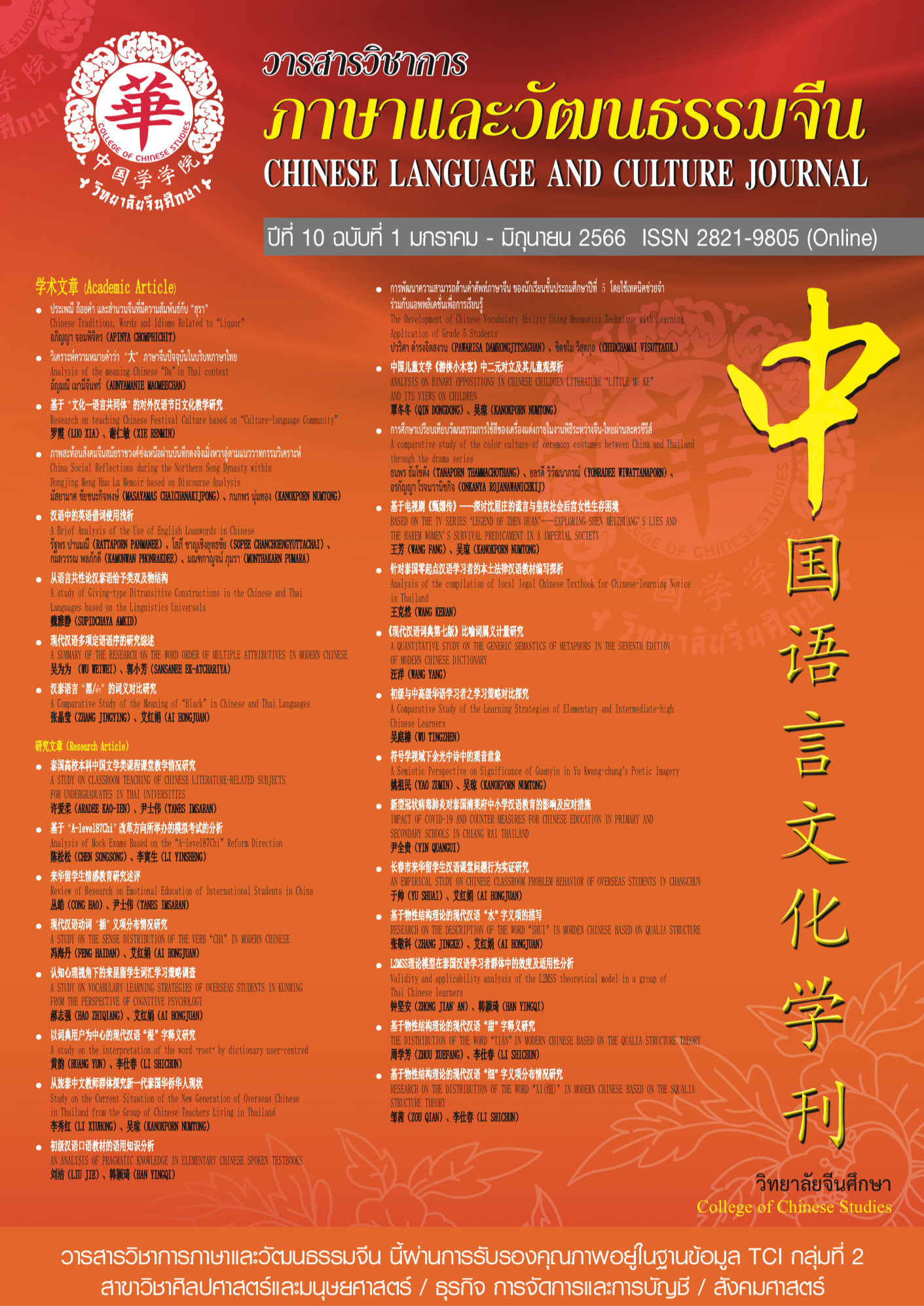RESEARCH ON THE DISTRIBUTION OF THE WORD "XI(细)" IN MODERN CHINESE BASED ON THE SQUALIA STRUCTURE THEORY
Keywords:
Squalia structure, Corpus, Semantic distribution, Semantic description, thinAbstract
This paper takes the word "XI(细)" as the research object, extracts enough corpus from the CCL corpus of Peking University, analyzes its sememe distribution in the real corpus and the prominent physical role of the corpus, and then according to the frequency of use, the meaning of the word reclassify and describe. On the basis of the existing 9 meanings in "Modern Chinese" (7th ed.)[Xiandai Hanyu Cidian(7th ed.)], 4 new meanings were found: "to describe the rain or the wind is weak", "the pulse condition of traditional Chinese medicine, which refers to the pulse as small as silk", "describe the style of the work gracefully""indicates that the frequency of action is not high or the degree of progress is not deep, which is equivalent to ‘slowly and gently’". In addition, according to the theory of qualia structure in the generative lexicon, the derivation between the meaning items of "XI(细)"is explained, which provides new basis for the existing dictionary definitions and optimizes and adjusts some meaning items.
References
[英] 霍恩比. 牛津高阶英语词典(第9版). [Z]. 北京:商务印书馆,2014.
[英] 柯林斯出版有限公司. 柯林斯 COBUILD 高阶英语学习词典. [Z]. 北京:外语教学与研究出
社,2006.
[英] 英国培生教育出版亚洲有限公司. 朗文当代高级英语辞典(第5版). [Z]. 北京:外语教
学与研究出版社,2010.
蔡仲凯、李贝贝.《中华同义词词典》形容词释义指示语研究. [J]. 绥化学院学报,2013,
(6):60-64.
方丹阳. 外向型学习词典中动词释义指示语研究:[硕士学位论文]. [D]. 广州:中山大学,
冯文博. 现代汉语词典联合型形容词释义元语言的句法语义规则研究:[硕士学位论文]. [D].河北:
河北师范大学,2007.
符淮青. 词的释义方式. [J]. 辞书研究,1980,(2):158-169.
符淮青. 词的释义方式剖析上. [J]. 辞书研究,1992,(1):20-29.
国家社会科学院语言研究所编. 现代汉语词典(第7版). [Z]. 北京:商务印书馆, 2016.
胡明扬. 词典学概论. [M]. 北京:中国人民大学出版社,1982.
李仕春. 汉英词典100核心词义项分布研究. [J]. 北华大学学报(社会科学版),2013, 14(6):9-
李仕春. 语料库视野下的现代汉语“绿”字义项分布研究. [J]. 山西大同大学学报(社会科学版),
,27(5):62-66.
李行健主编. 现代汉语规范词典(第3版). [Z]. 北京:外语教学与研究出版社,2010.
鲁健骥、吕文华. 编写对外汉语单语学习词典的尝试与思考——《商务馆学汉语词典》编后. [J].
世界汉语教学,2006,(1):59-72.
任念麒. 外用汉外教学词典的基础. [J]. 辞书研究,1984,(3):125-132.
任晓霓. 外向型学习词典形容词释义语言结构的对比与实验研究:[硕士学位论文]. [D]. 广州:
中山大学,2016.
商务印书馆辞书研究中心编. 现代汉语学习词典. [Z]. 北京:商务印书馆,2010.
苏新春. 现代汉语分类词典. [Z]. 北京:商务印书馆,2013.
孙全洲.《现代汉语学习词典》编纂中的探索. [J]. 辞书研究,1986,(3):83-88.
王还. 汉语词汇的统计研究与词典编幕. [J]. 辞书研究,1986,(4):106-108.
王还. 试编一本对外汉语教学用的词典. [J]. 辞书研究,1988,(4):50-51.
翁晓玲. 基于元语言的对外汉语学习词典释义模式研究——以《商务馆学汉语词典》为例:[博士学位论文]. [D]. 上海:华东师范大学,2011.
许慎. 说文解字. [M]. 北京:中华书局,2013.
徐玉敏. 对外汉语学习词典的条目设置和编排. [J]. 辞书研究,2001,(3):83-86.
颜娜. 词典释义提示用语的混乱例谈. [J]. 辞书研究,2009,(1):101-103.
杨金华. 释词简约有碍对外汉语词典发挥其应有的作用. [J]. 辞书研究,2007,(4):55-64.
雍和明. 英语词典史. [M]. 北京:商务印书馆,2015.
张津、黄昌宁. 从单语词典中获取定义原语的一种方法. [J]. 清华大学学报(自然科学版),1997,
(3):28-33.
张万有、张志毅、张庆云. 语文辞书的历时原则. [J]. 辞书研究,2000,(06):53-60.
章宜华. 学习词典释义结构与释义方法初探—英、法、汉语学习词典的对比研究. [J]. 上海外国语大学学报,1999,(3):73-78.
章宜华. 语义学与词典释义. [M]. 上海:上海辞书出版社,2002.
章宜华. 汉语学习词典与普通汉语词典的对比研究. [J]. 学术研究,2010,(9):151-160. 张志毅. “辞书强国”究竟有多远. [N]. 人民日报,2010-10-12(20).
张志毅、张庆云. 理论词典学. [M]. 北京:商务印书馆,2015.
赵贵仙.《汉语8000词词典》常用多义形容词的释义研究:[硕士学位论文]. [D]. 湖南师范大
学,2016.
周小兵. 对外汉语学习词典的编写. [J]. 辞书研究,1997,(1):82-86.
朱金平. 《商务馆学汉语词典》双音节形容词释义研究:[硕士学位论文]. [D]. 广州:暨南大学,
朱骏声. 说文通训定声. [M]. 北京:中华书局,1984.
Downloads
Published
How to Cite
Issue
Section
License
Copyright (c) 2023 Chinese Language and Culture Journal

This work is licensed under a Creative Commons Attribution-NonCommercial-NoDerivatives 4.0 International License.
บทความที่ได้รับการตีพิมพ์เป็นลิขสิทธิ์ของวารสารภาษาและวัฒนธรรมจีน มหาวิทยาลัยหัวเฉียวเฉลิมพระเกียรติ
บทความใน “วารสารวิชาการภาษาและวัฒนธรรมจีน” เป็นทรรศนะของผู้เขียนโดยเฉพาะ กองบรรณาธิการไม่มีส่วนในความคิดเห็นในข้อเขียนเหล่านั้น




